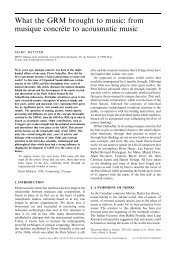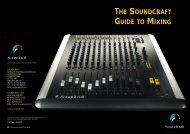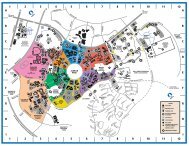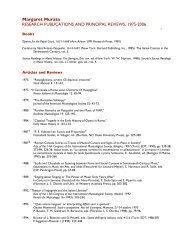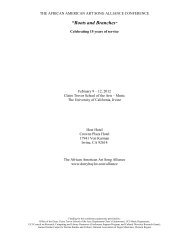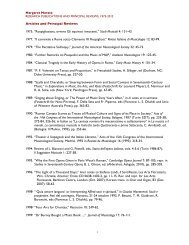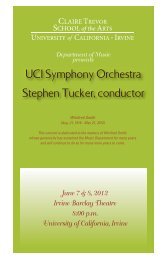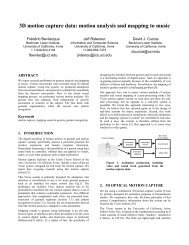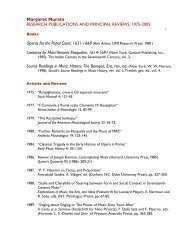You also want an ePaper? Increase the reach of your titles
YUMPU automatically turns print PDFs into web optimized ePapers that Google loves.
Further Study of Chord Types 42<br />
A summary of all the types of chords, their families, and their<br />
accompanying scales is given below for quick reference.<br />
Chord<br />
Family Chord Scale<br />
M7 (Tonic Major) M7 Major Scale<br />
MG Major Scale<br />
Tonic Minor m6 Ascending Melodic Minor Scale<br />
m~7 Ascending Melodic or Harmonic<br />
Minor Scales<br />
m7 m7 Dorian Mode*<br />
07 Locrian Mode<br />
7 (Dominant) 7 Mixolydian Mode<br />
7<br />
+5 Whole Tone Scale<br />
7<br />
b5 Whole Tone Scale<br />
Jazz is a relatively new art whose language and symbols are still<br />
in the process of becoming standardized. Consequently, the student<br />
of improvisation could easily become confused <strong>by</strong> encountering<br />
unfamiliar symbols found in chord progressions given him <strong>by</strong> play<br />
ers of another geographical location. Some of the deviations one<br />
might expect to encounter are:<br />
M7 Maj.7, 47<br />
m7 7<br />
7 -7<br />
$7 mIS, —5<br />
MS 6<br />
7 x7<br />
Figure 8 shows a new progression to the blues, this one in the<br />
minor mode and using some of the chords introduced in this<br />
chapter. This should be transposed for the various instruments<br />
* Traditional modal terminology is given because it is unnecessary to coin<br />
new terms for an old scale system.<br />
Further Study of Chord Types 43<br />
and used as a reference sheet for the next playing session. The<br />
scheduling of playing sessions from this point is left to your own<br />
discretion. There is no limit to the number of possible sessions, but<br />
one should be scheduled at least whenever there is new material to<br />
be assimilated.<br />
4 £<br />
cm6 Fm6 cm6<br />
~<br />
7<br />
c..5 Fm~7 (ascending melodic minor)<br />
11pflO~• {Ijj ,I...frs”’ 1.<br />
-4—91<br />
Cm~7 ( harmonic minor) 007<br />
44 ~ 1 1~jJ fr.,t1fr1”°I<br />
7<br />
G~5 cmkl (ascending melodic minor)<br />
p<br />
L_ —<br />
—<br />
— 0 -L<br />
-<br />
-<br />
~<br />
4<br />
FIGURE 8<br />
(•<br />
projects<br />
1. Write and practice (in arpeggiated form on the instrument) the<br />
77<br />
M6, m6, m*7, (or m~7), ~7, +5, b5 chords in all keys.<br />
2. Write the melodic minor, harmonic minor, Locrian Mode, and<br />
whole-tone scales in all keys. (There are only two whole-tone<br />
scales. You will find the others are all repetitions of one or the<br />
other.)<br />
8. Above each of the written scales, write the chord root and chord<br />
type which can be used in conjunction with the scale.<br />
4. Transpose to all keys and practice the following pattern of scales.<br />
Play continuously, stopping only for breath.



